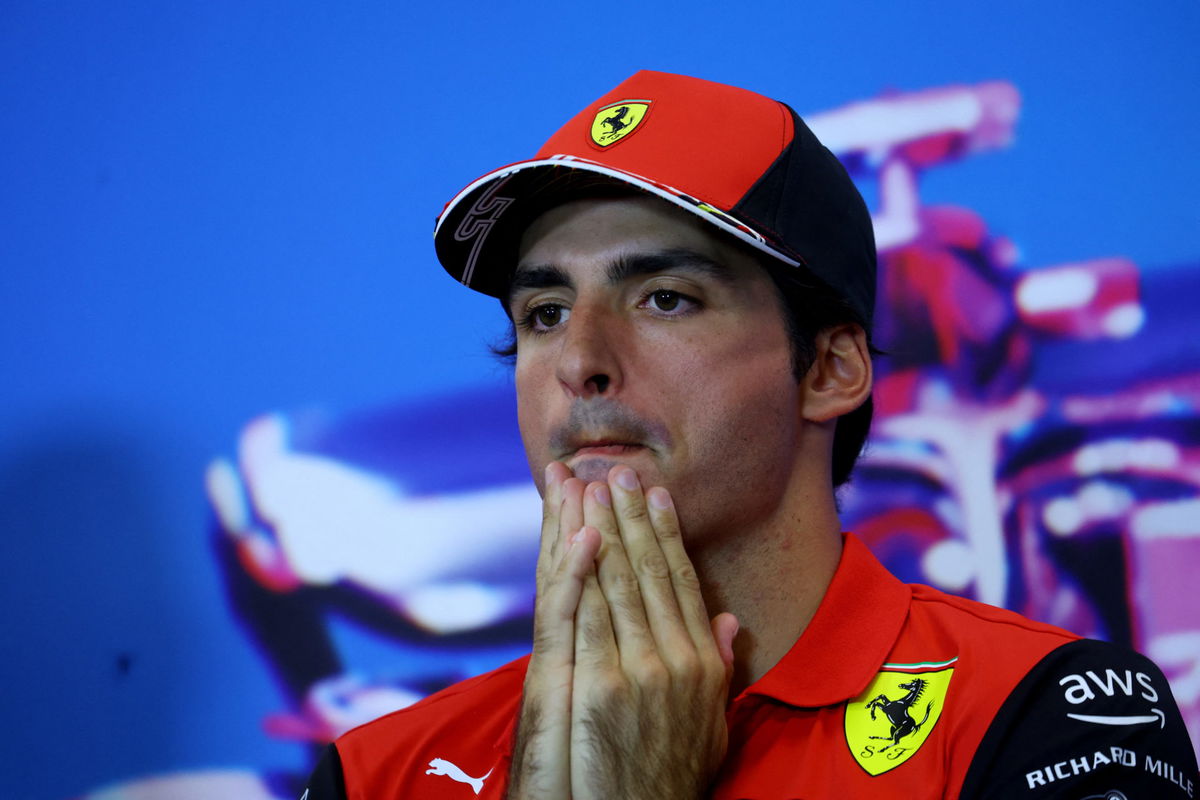
Reuters
Formula One F1 – United States Grand Prix – Circuit of the Americas, Austin, Texas, U.S. – October 20, 2022 Ferrari’s Carlos Sainz Jr. during a press conference ahead of the United States Grand Prix REUTERS/Mike Segar

Reuters
Formula One F1 – United States Grand Prix – Circuit of the Americas, Austin, Texas, U.S. – October 20, 2022 Ferrari’s Carlos Sainz Jr. during a press conference ahead of the United States Grand Prix REUTERS/Mike Segar
The most awaited race weekend of the 2023 F1 season is finally here. However, the first session came to an abrupt end even before all the cars could do a lap around the track. Carlos Sainz’s floor was shredded to pieces by the manhole covers which caused a Red Flag. The session wasn’t restarted as the hurt SF23 was taken back to the pits and work to secure the covers was started. With Ferrari having to change parts worth hundreds of thousands of dollars, should F1 relax the $135 million cost cap for an incident caused by their oversight at the Las Vegas GP?
Watch What’s Trending Now!
Carlos Sainz’s SF23 got badly hurt within the first 10 minutes of the FP1 session after his car ran over a manhole cover. The cover was sucked off the ground and hit the floor of Sainz’s car causing damage to it along with some other components. As a result, Ferrari had to change multiple parts to make sure the car was good to run again for the FP2 session. The question arises, why are the teams having to make the extra effort and pay for F1’s oversight?
🚨 BREAKING: Ferrari has changed Carlos Sainz's chassis, ICE, Energy Store and Control Electronics due to the FP1 damage, which would usually result in a grid penalty.
Ferrari however may be able to argue against a penalty as the damage was as a result of substandard track… pic.twitter.com/geMpUsr1tC
— Fastest Pitstop (@FastestPitStop) November 17, 2023
ADVERTISEMENT
A similar incident happened back in 2019 during the Azerbaijan GP where George Russell’s car was damaged by a drain hole cover. However, back in the day, the cost cap rules weren’t as strict and tight as they are today. Teams only get $135 million for the whole season. And crashes and incidents like this definitely add up to the cost of the teams. It is believed that one of the reasons why Mick Schumacher was let go by Haas was because he crashed the car way too many times and cost the team a lot.
As an aftermath of the incident, Ferrari had to change the chassis, internal combustion unit, energy store, and control electronics on Carlos Sainz’s SF23. The cost of the parts exceeds the million-dollar mark. With the cost cap being as tight as it is, F1 should consider giving some leeway to teams like Ferrari who met with a heavy repair build as a result of an incident caused by F1 and the organizer’s oversight.
Read More: F1 Fans Lose Thousands of Dollars as Las Vegas GP Organizers Disallow Entrance for FP2
ADVERTISEMENT
That being said, it’ll be very difficult for the FIA and F1 to make a rule around this problem. How does one exactly measure the cost of the total damage? It doesn’t look like F1 will make any relaxation to the cost cap. Especially when you consider that F1 didn’t even hesitate to punish Sainz for an incident caused by their oversight with no fault of the driver or the team.
ADVERTISEMENT
Carlos Sainz handed a penalty after the FP1 crash in Las Vegas
As we’ve already mentioned, Ferrari had to change multiple components on Carlos Sainz’s SF23 as a result of the manhole cover hitting the car. Ferrari asked the stewards to let them change the components on the car without receiving a penalty as the issue was caused by external circumstances. However, the FIA rejected Ferrari’s request and Carlos Sainz was handed a penalty for changing the battery. It is going to be a 10-place grid penalty for Sainz.

Imago
F1 Austrian Grand Prix 2023 Sprint Shootout And Sprint Carlos Sainz of Ferrari during press conference, PK, Pressekonferenz after Sprint ahead of the Formula 1 Austrian Grand Prix at Red Bull Ring in Spielberg, Austria on July 1, 2023. Spielberg Austria PUBLICATIONxNOTxINxFRA Copyright: xJakubxPorzyckix originalFilename:porzycki-f1austri230701_nppSo.jpg
Explaining the reason for rejecting Ferrari’s appeal, FIA released a statement that read, “The Stewards determine that, notwithstanding the fact that the damage was caused by highly unusual external circumstances, Article 2.1 of the Formula 1 Sporting Regulations obliges all officials, including the Stewards, to apply the regulations as they are written. Accordingly, the mandatory penalty specified under Article 28.3 of the Sporting Regulations must be applied.”
ADVERTISEMENT
WATCH THIS STORY | Most Dangerous Crashes in F1 History
Top Stories
‘Helped My Humanity’: Lewis Hamilton Lays Bare Truth of Travel Bug Amidst Heritage Visit in Benin

Who Is Oscar Piastri’s Father, Chris Piastri? Co-Founder of Multibillion Dollar Automotive Company

Language Barrier Didn’t Hold Back Lando Norris to “Hook Up” With OnlyFans Model: “We Talked by Mime”

Carlos Sainz & Ex Girlfriend Isa Hernaez Issue Contrasting Statements to Stir the Pot After Unexpected Breakup

Who is Ayumu Iwasa? The Red Bull Junior Team Driver from Japan

Sainz & Ferrari may feel hard done by, with the strict application of the FIA rules after their uninitiated Vegas fiasco. What do you think, should the FIA give the Scuderia a bit of leeway in terms of the cost cap? Or will it open a Pandora’s box of several such unusual mitigating circumstantial requests from the other teams?
“The views expressed are those of the author and do not necessarily reflect the views of EssentiallySports.”
ADVERTISEMENT
ADVERTISEMENT
ADVERTISEMENT
ADVERTISEMENT

